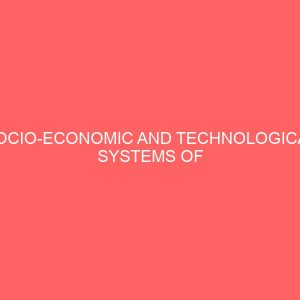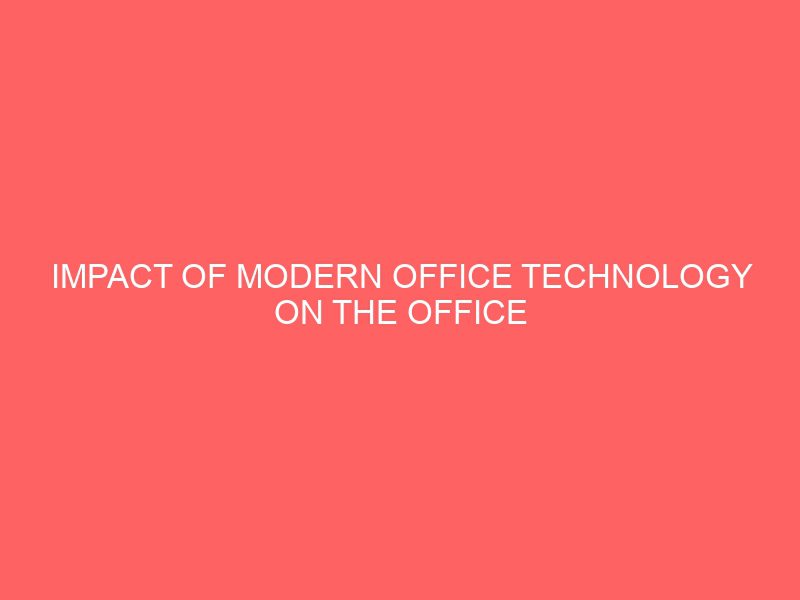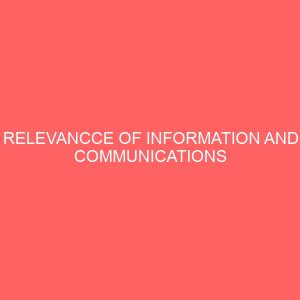Description
CHAPTER ONE
1.0 INTRODUCTION
1.1 Background to the study
For decades now, fast changes have been taking place in all facets of human life including the office environment. This is as a result of technological advancement. Every office in today?s business world, be it government, industry or other human endeavors, require facts and accurate information for quick decision-making. The office worker, including the office manager, expects certain support from the organization into which he/she is employed. This support can be technological (machines and equipment) and human. In offices of past, manager?s dictated memos and letters and office managers typed them. Most recently, business have developed word processing centers and relied on personal computers and even electronic mail in an effort to lessen the need for office manager support and make the employee-office manager very productive (Ezoem, 2005; Osuala, 2004).
As a result of changes in technology, the role of office managers in business has changed tremendously from that of typewriting and shorthand dictation, answering of telephone calls and processing of mails. Today?s office managers are exposed to office technology including the internet that make work much easier and knowledge more accessible (Edwin, 2008). It is now easier to send messages by telex, electronic mails (e-mails), fax and telephones. Other office gadgets available to the office manager are photo-copy machines, duplicating machines, dictating machines, printers, among others. This is the era of computers and information technology which has become an enabler of greater convenience. Three of the most popular types of computer software programs are word processing, which help the user to write and edit memos, letters and reports, data management programs or databases, which help the user/ office manager to use long lists of data and spreadsheet programs, which handle tables and numbers (Dulek and Fielden, 2009).
Office managers now have many technologically advanced office gadgets to ease their jobs and enhance proficiency and productivity leading to improved access to goods and services globally (Wofersohn, 2001). There are wide range of office machines and equipment which now enable office managers to improve their performances. Such new machines take the form of electronic typewriters that have replaced the manual ones. Word processors with milt-purpose facilities, computers and other sophisticated office machines and equipment are now provided by employers. Some of the physical equipment used by office managers includes computer communication equipment and electronic pocket organizers (Lucas, 2007). New technological equipment that has altered the procedures and technique for office functions include the computers, electronic mail/ commerce, voice mail, and the Internet.
However, these new developments brought by technological challenges require even more knowledge and skills beyond being a professional office manager. For the office manager to be abreast with the changing times, face the challenges and overcome the old ways of doing things she or he needs training requirements in recent times to help meet organizational objectives. Information technology has affected many professions in recent times. The roles of office manager professionals have been turned around by technology. It has provided the tools that shift the role of office managers from that of information recorders to business strategists (Appah and Emeh, 2011). Several other authors are of the view that the office manager has to be well equipped to meet the present challenges of a modern office.
1.2 Statement of the Research Problem
An automated office, undoubtedly, offers new roles and responsibilities for the office manager. Such new roles presuppose that additional training and qualifications are required from the office managers. The relevance of automation in business was identified by Aromolaran (2003) as follows
i.) Creating a distinct career path for the office manager.
ii.) Automation creates a prominent place for the office manager on the organization chart.
iii.) It creates routine and assigned roles for the office manager.
iv.) With automation the office manager now spends less time in correcting, revising, proof-reading and reproducing documents.
Cameron (2002), a very long time ago, commented that it takes up to 10 to 15 years between the introduction of new equipment in the market and its installation in small organizations. This is particularly peculiar to private business organizations in developing countries. In modern times, it is not uncommon to find some organizations still subjecting office managers to the use of manual typewriters. When office managers are not provided with efficient and effective working tools, productivity is definitely bound to be low.
Duniya (2011) also observed that due to the introduction of sophisticated technological (electronic) office equipment into today?s office and the role office managers need to play in ensuring accuracy and efficiency in their jobs, the office managers need to meet the challenges by acquiring new skills and competencies for efficient operations in the electronic office. There is continuous advancement in technology which has affected the office manager profession in terms of the quality, speed and accuracy of works performed.
This study is therefore undertaken in order to gain understanding about the impact of modern office technology on office managers? productivity at the Procter & Gamble Nigeria Plc. Ibadan
1.3 Objectives of the Study
The broad objective of the study is to examine the impact of modern office technology on office managers? level of productivity at the Procter & Gamble Nigeria Plc. Ibadan. Specifically, the study aims at achieving the following objectives.
i. To ascertain the range of new office technology existent at the P&G Plc.
ii. To investigate the level of usage of these new office technology in P&G Plc.
iii. To know what productivity is and standard using for measurement in P&G Plc.
iv. To identify the level of productivity of the office managers at the P&G Plc.
1.4 Research Questions
In order to achieve the objectives of this study a number of questions would be explored. Consistent with the topic and objectives the following questions will guide the study;
i. What are new office technology in P&G Plc.?
ii. What ranges of new office technology exist at P&G Plc.?
iii. What is productivity and how is it measured in P&G Plc.?
iv. Does the introduction of office technology impact on office managers? productivity in P&G Plc.?
1.5 Scope of the Study
Geographically, the study covered the P&G Nigeria Plc. which is situated at the department enclave in the Oyo state metropolis as a case study. Contextually, the study focused on modern office technology and their impact on office managers? productivity.
1.6 Significance of the Study
To date, just a handful studies have been published that looks at modern office technology and office managers? productivity in African nations and more particularly, in Nigeria. This study intends to contribute to a greater comprehension of the subject of matter. From a practitioner?s perspective, the results of the study will provide a benchmark that can be used in assessing the effectiveness of the implementation of new office technology in an office environment as well as define key productivity factors.
Finally, this study will provide a foundation for future studies as this will serve as a motivation for many researchers to further examine other aspects of the subject matter.
1.7.1 Organisation of the Study
This study is organized into five chapters. Chapter one of the thesis discusses the overview of the study, problem definition, research question, research objectives, significance of the study. Chapter two presents all the relevant literature review on waste management and its related concepts. Chapter three addresses the identification of the most suitable research methodology for this research and chapter four presents a data analysis of findings gathered from the field. Finally, chapter five presents the summary of findings, conclusion, and made relevant recommendations.
1.8 Limitations of the Study
Indeed, there is the anticipation of various challenges which may be encountered as the researcher undertakes this study. However, measures have been established in to curtail the said challenges. Some of those challenges could be: difficulty in retrieving data, limited time for the study, and the financial commitments. This called for the limited and careful selection of population and samples of the study into a manageable one and the requirement of immense work in data sourcing and information mining from the respective bodies.
1.9 Operational Definition of Terms
Modern equipment: These refers to the usage and knowledge of tools, machines, techniques, crafts, systems or methods of organizing in order to solve a problem or perform a specific function.
Productivity: is commonly defined as a ratio between the output volume and the volume of inputs. In other words, it measures how efficiently production inputs, such as labour and capital, are being used in an economy to produce a given level of output.
Efficiency: The ability to perform duties well to produce the desired or satisfactory result.
Policies: Plan of action made by Business Company to meet aims and objectives.
Office manager: A person employed to be in charge of the clerical, organizational and administrative functions of the organization.
Machines: Appliance or mechanical devices with parts working together to apply power.
Automation: Has to do with the use of machines. The machine appears of itself to make its own decision without guidance from the brain of a man.
Technology: refers to methods, systems, and devices which are the result of scientific knowledge being used for practical purposes.
Technological Age: the era or time of using mechanism to solve problems.







